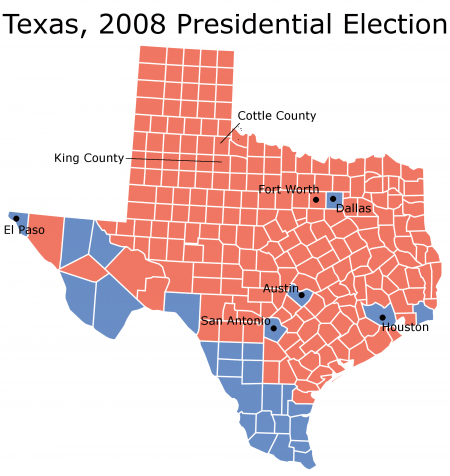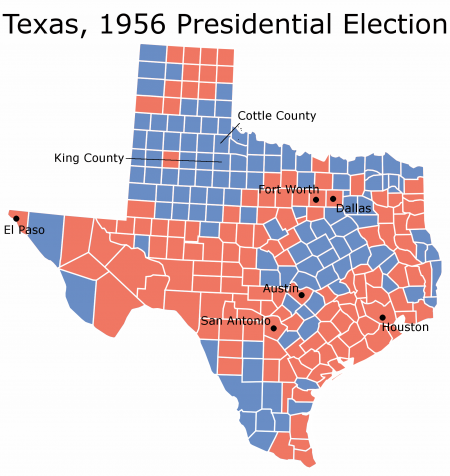This is the first part of two posts examining the Texas panhandle, a rock-hard Republican stronghold. The second part can be found here.

In the Texas panhandle and the empty plains surrounding it, Democrats go to die. There is no place in the country more Republican than this rural region, where conservatism is ingrained bone-deep and from birth. Not even the most Mormon stretches of Utah, or whitest areas of the Deep South, exceed the Republicanism of this part of Texas.
Yet, in the vast emptiness of the Texas prairie there are a number of interesting patterns – some of which are quite strange to behold.
More below.
Yellow-dog Democrats
Believe it or not, much of the most Republican place in the nation used to be Democratic territory, voting for the blue candidate even when the rest of America did not. Now, of course, the same could be said for the entire American South, which routinely gave badly losing Democratic presidential candidates over 70% (and often 90%) of the vote. Texas was no exception to this rule; President Truman lost a grand total of eight counties during the 1948 election, for instance.
The difference with the Texas panhandle, however, was that parts of it continued to vote Democratic even as the Solid South collapsed. In 1956, for instance, President Dwight Eisenhower won re-election by a solid 15.40% and cracked the South. One such crack included Texas, which Mr. Eisenhower won by 11.28%. Mr. Eisenhower carried the state backed mainly by its Republican-leaning cities (an oxymoron nowadays), while much of rural Texas voted for Democrat Adlai Stevenson. This included almost the entire panhandle:

This Democratic-leaning trend continued for some time, even after the 1964 realignment of the South. The panhandle cast a strong ballot for Senator Hubert Humphrey and President Jimmy Carter (both times), while a number of counties voted to Governor Dukakis and even hapless Senator Walter Mondale. As late as 1996, when President Bill Clinton lost Texas by 4.93%, there still remained a flicker of yellow-dog Democratic strength:

It was one President George W. Bush who finally crushed this Democratic tradition; since his time, the panhandle has begun voting uniformly Republican. But for all its current love of Republicans, it must be noted that this phenomenon is relatively recent – although long in coming.
I would have liked to have seen the 1968 texas presidential map. Eisenhower was from Denison, in Cooke county. Funny to see counties like Collin voting for Adlai Stevenson in 1956. That county voted 75% Republican in the 90s and 2000s and went 62-38 for McCain.
In 1996 Clinton was able to win the yellow dog Democratic counties with the help of Perot in 1992 and 1996.
in the panhandle are now hispanic majority. Of course, most of these people can’t and don’t–yet.
Here’s a question: why is Foard County still relatively more Democratic than the rest of the area?
awesome.
Ruled back then and it still ruled until the 90’s when people realized how Democrats did not match their views.
a county which only gave Obama eight votes. It’d be pretty interesting to try and do a documentary where someone goes out and tries to find those eight people.
The most Republican congressional district in the country, TX-13, which had most of the Panhandle and parts of Lubbock and Amarillo during the 90s, was represented by Bill Sarpalius, a Democrat, until just over 15 years ago. And Charlie Stenholm represented parts of West Texas until 2005 and might still be in office today if not for the Delaymander that cost him his seat. Keep in mind that many of these areas in West Texas were already heavily Republican by the early 1990s on the Presidential level, while still sending Democrats to Congress.
Democrats did somewhat well in state legislative elections in West Texas until the 90s. Lubbock and Midland were both represented by a Democrat in the state senate until 1996. Several counties in West Texas even voted for Chris Bell in 2006. One of the state house districts in West Texas is still represented by a Democrat, despite McCain getting more than 70% of the vote in the district. So while West Texas is heavily Republican on all levels, it wasn’t so until the 90s and there are still a few remnants of Democratic hegemony, however rare they may be.
that Harris and Dallas counties have turned blue.
Rep. Kent Hance was a very conservative Democrat who defeated George Bush in 1978 to represent TX-19, which was then made up of Lubbock and Midland/Odessa. He ran for U.S. Senate in 1984 but lost a very close primary runoff to the much more liberal state sen. and now Rep. Lloyd Doggett, who lost badly to Phil Gramm. If Hance had won the primary, could he have defeated Gramm that year?
A green rat, perhaps?
Because yellow is often used to represent the Libertarian Party and the Libertarians and Greens are the two major minor parties these days so green is “opposed” to yellow in that sense.
(Also because green is in contrast to yellow as one of the four “major primary colors” usually found in a box of four crayons distributed for free from an upscale family restaurant. Also because wind and earth are “opposed” and it seems customary for some fantasy games to show wind as green and earth as yellow for representation colors.)
And a rat because it’s also a three-letter animal name and it also starts with the same letter as its corresponding party.
“They’d vote for a green rat before they’d vote for any Democrat!”
I will get the county results for at least Hance/Doggett/Kreuger, which was a 3-way split (33/33/33) that had to show obvious regional strongholds on display.
There’s a few panhandle counties north of Amarillo that won’t be holding Democratic Primaries because there is no Democratic county committee in that county.